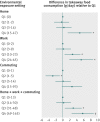Associations between exposure to takeaway food outlets, takeaway food consumption, and body weight in Cambridgeshire, UK: population based, cross sectional study
- PMID: 24625460
- PMCID: PMC3953373
- DOI: 10.1136/bmj.g1464
Associations between exposure to takeaway food outlets, takeaway food consumption, and body weight in Cambridgeshire, UK: population based, cross sectional study
Abstract
Objectives: To examine the association between environmental exposure to takeaway food outlets, takeaway food consumption, and body weight, while accounting for home, work place, and commuting route environments.
Design: Population based, cross sectional study, using data on individual participants' diet and weight, and objective metrics of food environment exposure.
Participants: Working adults participating in the Fenland Study, Cambridgeshire, UK (n = 5442, aged 29-62 years), who provided home and work addresses and commuting preferences. Takeaway food outlet exposure was derived using data from local authorities for individual environmental domains (at home, at work, and along commuting routes (the shortest route between home and work)), and for exposure in all three domains combined. Exposure was divided into quarters (Q); Q1 being the least exposed and Q4 being the most exposed.
Main outcome measures: Self reported consumption of takeaway type food (g/day; pizza, burgers, fried foods, and chips) using food frequency questionnaires, measured body mass index, and cut-offs for body mass index as defined by the World Health Organization.
Results: In multiple linear regression models, exposure to takeaway food outlets was positively associated with consumption of takeaway food. Among domains at home, at work, and along commuting routes, associations were strongest in work environments (Q4 v Q1; β coefficient = 5.3 g/day, 95% confidence interval 1.6 to 8.7; P<0.05), with evidence of a dose-response effect. Associations between exposure in all three domains combined and consumption were greater in magnitude across quarters of exposure (Q4 v Q1; 5.7 g/day, 2.6 to 8.8; P<0.001), with evidence of a dose-response effect. Combined exposure was especially strongly associated with increased body mass index (Q4 v Q1; body mass index 1.21, 0.68 to 1.74; P<0.001) and odds of obesity (Q4 v Q1; odds ratio 1.80, 1.28 to 2.53; P<0.05). There was no evidence of effect modification by sex.
Conclusions: Exposure to takeaway food outlets in home, work, and commuting environments combined was associated with marginally higher consumption of takeaway food, greater body mass index, and greater odds of obesity. Government strategies to promote healthier diets through planning restrictions for takeaway food could be most effective if focused around the workplace.
Conflict of interest statement
Competing interests: All authors have completed the ICMJE uniform disclosure form at
Figures


Comment in
-
Takeaway food and health.BMJ. 2014 Mar 13;348:g1817. doi: 10.1136/bmj.g1817. BMJ. 2014. PMID: 24625461 No abstract available.
-
Plus il y a de fast-foods près de votre lieu de travail, plus votre risque de prendre du poids est grand!Rev Prat. 2014 Apr;64(4):472. Rev Prat. 2014. PMID: 24855779 French. No abstract available.
References
-
- Swinburn B, Egger G. Preventive strategies against weight gain and obesity. Obesity Reviews 2002;3:289-301. - PubMed
-
- The Strategy Unit Cabinet Office. Food: an analysis of the issues. 2008. http://webarchive.nationalarchives.gov.uk/+/http://www.cabinetoffice.gov....
-
- Burgoine T, Lake AA, Stamp E, Alvanides S, Mathers JC, Adamson A. Changing foodscapes 1980-2000, using the ASH30 study. Appetite 2009;53:157-65. - PubMed
-
- McPherson K, Marsh K, Brown M. Tackling obesities: future choices—modelling future trends in obesity and the impact on health. Government Office for Science, 2007. www.bis.gov.uk/assets/foresight/docs/obesity/14.pdf.
-
- Cavill N, Rutter H. Healthy people, healthy places briefing: obesity and the environment: regulating the growth of fast food outlets. Public Health England, 2013.
Publication types
MeSH terms
Grants and funding
LinkOut - more resources
Full Text Sources
Other Literature Sources
Medical
